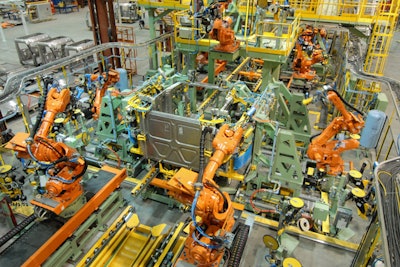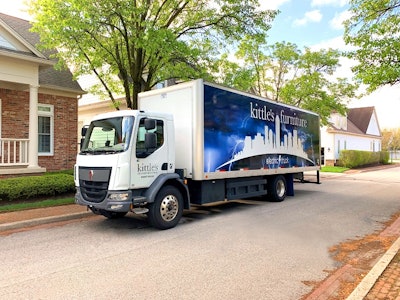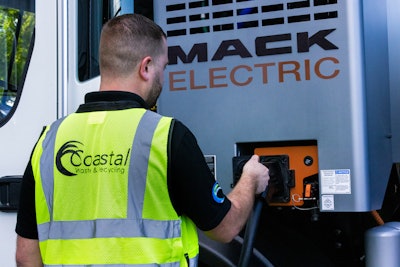In some areas, battery-electric commercial trucks have already been introduced. The segment is growing, whether you like it or dislike it. BEVs will be a major part of the future of zero-emissions commercial vehicles, whether they are pushed by government regulations or corporate sustainability.
[RELATED Navistar’s Carlbaum says that electrification is inevitable, but not without challenges ]
Suppliers are preparing to produce parts for these high-tech vehicles. While most of these trucks are still new enough to be repaired by the manufacturer for a few years, opportunities for the heavy-duty post-market are beginning to emerge.
Dealers are also struggling with the question of how to service BEVs. The answer may be to keep things simple.
 Robots at Daimler Truck North America
Robots at Daimler Truck North America
Truck makers
The original equipment specified in the trucks at the factory is the starting point for component selection. BEVs are heavier, hotter, and have less vibration compared to internal combustion engines. There are special considerations when choosing components.
“Traditional vehicles are powered by low-voltage systems (12 volts or 24 volts), but BEVs need high-voltage (400 volts to over 800 volts). This introduces new complexity in component selection and design,” said Tyler Ohlmansiek Mack Trucks director for e-mobility.
[RELATED Mack Trucks at 2024 ACT Expo with electric trucks news ]
BEV components need to be able handle higher voltages. They also need better insulation and protection from voltage spikes and arcing. BEV components need to be able handle higher voltages and heat. They also need to work well with other magnetic parts. The trucks must also step down the high voltage to run auxiliary systems which operate on lower voltages.
Bobby Compton, product manager, regional haul at Volvo Trucks, explains that some components are 12-volt, while others are 24-volt. “We have two 12-volt battery packs, but they are wired together to create 24 volts.” The truck is equipped with a DC-to DC converter to ensure that the correct voltage reaches the right place.
Volvo says that the diesel and the electric versions of its VNR tractors are very similar, sharing many parts, including the doors, the structure, and the driveline components.
Compton says, “We wanted our customers and dealers to be able to adapt to this major change as easily as possible by keeping as many things in common as we could.”
Electric motors also deliver power differently, so many BEV transmissions differ, including Volvo’s. It is a two speed transmission, but it is still a Volvo I Shift. Kenworth ‘s BEV Transmissions are also different than their internal combustion counterparts.
Sarah Abernethy is Kenworth’s marketing manager for powertrains. She says that due to the unique power curve and torque delivery of a BEV you don’t need the 18-speed or 12-speed options you would have with traditional diesels.
Abernethy emphasizes that Kenworth trucks are custom-tailored to the buyer and application. The model and construction of Kenworth’s BEV and diesel trucks determine the differences in design. Abernethy claims that the rear of e-axle vehicles such as the T680E will be very different from a diesel T680. Abernethy says that for a midships engine, the rear axle, driveline, and suspension will all be similar to a truck with a diesel motor.
[RELATED Mack builds off-grid charging systems into electric models ]
The companies have also had the move systems that run on a belt traditionally from the diesel engine. BEVs still have climate control, power steering, and other controls, but they are now powered by electricity.
Abernethy says that you will see some variations in the HVAC, power-steering, controls, and accessories.
The air systems at Daimler are also different.
Sam Saia is the product marketing manager at eMobility. “Air tanks, piping, and dryers will still be required, but a gear-driven compressor is no longer an alternative,” he says. BEVs need their own solutions to charge, convert power and distribute high voltage. Whereas ICE trucks use lubrication and fueling systems, BEVs do not.
Len Copeland is the product managing manager at Detroit. He says, “We took the opportunity to develop unique features that will make the day of a fleet manager/driver easier.” “Our BEVs have a charger management system that allows owners to validate charging status for multiple vehicles and even determine the start and stop charging time to manage energy prices in peak- and mid-electricity price zones.”
Navistar claims that the lack of vibration has a trickle down effect on components.
Scott Smay is the director of vehicle integration and engineering. He says that BEVs will have less vibration felt by the driver than ICEs due to their engines. This improvement does not affect the design or selection BEV components, but it does require additional attention to eliminate other noises such as buzzing or squeaking on common cab or inside components.

Timken manufactures motion solutions such as this clutch and brake. The company claims to source materials that can handle higher temperatures, increased speeds and higher speeds for BEVs.
Timken
Component suppliers
Suppliers are adapting components to the unique operating environment of BEVs.
Ohlmansiek explains that Mack takes into account several factors when designing parts for its BEVs. The supply chain of suppliers must be reliable, and the components that they deliver must be durable and serviceable. The parts must also be light, use space efficiently and be supported well in the aftermarket.
Gates Corporation manufactures fluid power and transmission solutions. This includes hoses for BEVs, electric water pump, coolant valves, and oil cooler lines. The team consists of Frank Woodson as training manager for the North American aftermarket, Ken Pancoast as global product manager, automotive, Robert Schuld as global product manager, automotive, Chris Hack and Brian Holt (global EV product manager) respectively.
In a prepared statement, the team states that “most of our efforts revolve around the cooling system.” “Hose connectors are also crucial parts of the system, and must be designed in order to work within limited spaces when batteries are stacked on top of each other.”
Cooling systems are essential to maintain batteries at an optimal temperature. These systems must also be durable. The Gates team explains that thermal management systems work even when the vehicle’s not running. This system is running even as the truck is charging to keep the batteries at the optimal temperature.
Hendrickson manufactures heavy-duty suspensions that are essential for BEVs. Jeff Zawacki is the vice president of the advanced technology group at the company. He says that these components will be similar, but they may have some material differences specific to BEVs.
[RELATED: Hendrickson acquires Reyco Granning]
He says that the electric driveline will eliminate all the exhaust emission parts, and motor rewinding would likely replace engine rebuilds over time.
Timken manufactures bearings and other motion products for industrial applications including heavy duty commercial vehicle.
Derek Martin, senior application engineering at the company, says, “Every mile counts in a BEV. So component efficiency and reduced heating can be vital for extending the range and battery of the vehicle.” “This is a factor in how we design and create bearings. From enhanced surfaces to optimized geometries and the proper sizing. All of these elements are essential for improving driveline efficiency and maximising a vehicle’s overall performance.
Timken, he says, works with its customers – including OEMs – to select the best solution in terms of performance and sustainability. In BEVs this means choosing materials that can withstand higher temperatures and faster speeds. OEMs are also trying to simplify their component lists and increase their speed of market. Volvo is using components designed for diesel trucks to build their BEVs.
“In every case, we work with our customers to determine the most efficient, best-performing option,” Mankin explains, adding that, now that first- and second generation BEVs are in the field, the company has seen an increase in the number of clean-sheet designs, rather than repurposing existing parts. Timken is ready for either scenario.
“Whether it’s selecting from our portfolio or innovating to create something new, we’ll work with our customers and identify the best solution,” he said.

Palmer Leasing delivered this electric Kenworth Cabover to Kittle’s Furniture, located in Indiana. Kenworth says that dealers can keep the right BEV parts in stock by knowing their customers, their applications, and needs.
Kenworth
Dealers
Mack provides dealers with a recommended inventory list for its battery-electric products. This includes parts that are essential for servicing and maintaining the vehicle, as well as those that are frequently used. The list includes brake components, thermal control system components and serviceable electrical components like converters, inverters, sensor and control units.
[RELATED How to effectively market alternative power ]
Ohlmansiek recommends that dealers take the list and customize it to local needs.
By focusing on these components and adjusting their stock to local demand, dealers can ensure that they are prepared to service BEVs in their area of responsibility efficiently.
Volvo has a strategic approach to its VNR Electrical. Compton says that certifies EV dealerships across the country, and that it ensures before a VNR is deployed, there are certified EV dealerships in the area. Compton says that part of the certification process involves determining the key components to have on hand for the truck.
Daimler is also focused on maintaining uptime. It advises dealers to stock critical parts to keep their trucks on road.
Saia advises that “my second piece of advice is to stock components which are already known and have been carried over, or which are similar to previous ICE versions” at the same rate.
Kenworth’s Abernethy said that dealers must ensure the BEVs sold are used properly, within the weight and range limits. This, along with knowing the parts customers need, comes back to a thorough knowledge of what the trucks do in the field.
She says that dealers must know their customers well in order to determine the best way to stock their vehicles, both BEVs and diesels.
Navistar also sends a list of parts to its dealers for both BEVs and diesel engines. Some parts are only available at parts distribution centers and can be shipped out immediately when needed.

A Mack electric refuse vehicle is plugged in to charge. Thermal management systems that run even when trucks are charging are an opportunity for the heavy duty aftermarket to provide battery electric trucks.
Mack Trucks
Aftermarket
As BEVs get older, the aftermarket can innovate. The Gates team believes that thermal management system components are a key area for aftermarket growth, largely due to their heavy use cycle.
[RELATED Schwartz and MacKay look at future powertrains ]
The team also says that the replacement rate for BEV electric pumps has been similar to that of internal combustion engine electric pumps. “We know parts on BEVs will fail and wear,” they say.
Gates also says that brakes and suspension components will be available due to the heavier weight of BEVs.
Volvo’s Compton said he wants body builders to have a greater role in the BEV Aftermarket. They can configure things like liftgates and refrigerators to work with electric trucks.
“Technology is going to continue to improve and evolve, opening up new possibilities,” he said.
The aftermarket can help customers improve their uptime.
Saia says, “I would imagine readiness with large critical aggregates available would be paramount in addition to systems which are already well known as common issues such as harnessing cooling and air systems.”
Smay, from Navistar, said that his company is looking at the aftermarket for more simple components such as coolant pump, valves, and cooling modules.
Dave McCleave is the director of aftermarket for Hendrickson and he advises dealers to continue to know their customers as BEVs continue to make their way into the heavy-duty market. By paying attention to fleets that run BEVs, and how they use them, they can determine which parts wear out faster. These parts should be kept on-hand.
McCleave says that this will ensure maximum equipment availability with local inventory. “The less strategic, longer-wearing components or large-space products should be inventoried in a national distribution centre.”